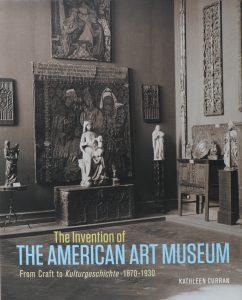Hartford’s own Wadsworth Atheneum factored into the 13 years of research, writing, and editing that went into a new book by Trinity College Professor of Fine Arts Kathleen Curran. The Invention of the American Art Museum: From Craft to Kulturgeschichte was published recently by Getty Research Institute in Los Angeles.
 The book examines the origins of the American art museum in the 19th century. Curran, who is the director of Trinity’s art history program, found that writing the book in Hartford gave her a great advantage. “Any book on the American art museum would have to include Hartford’s Wadsworth Atheneum,” she said. “It plays an important role in the history of American art museums at a few key moments in time.”
The book examines the origins of the American art museum in the 19th century. Curran, who is the director of Trinity’s art history program, found that writing the book in Hartford gave her a great advantage. “Any book on the American art museum would have to include Hartford’s Wadsworth Atheneum,” she said. “It plays an important role in the history of American art museums at a few key moments in time.”
Curran argues that museums in this country have their own trajectory that is different from European art museums. European museums have origins in their aristocratic collections, she said, while American museums are rooted in the 1870s craft museum. At the turn of the 20th century, American planners grew enthusiastic about a new type of museum that was developed in Northern Europe. These Kulturgeschichte (German for “cultural history”) museums offered a variety of transformational options in planning museums, classifying and displaying objects, and broadening collecting categories, including American art and the decorative arts. Curran’s book looks at the development of the American art museum, from the beginning of craft style to the eventual development of Kulturgeschichte museums.
In her book, Curran addresses the 1910 addition to the Wadsworth Atheneum that was paid for by J.P. Morgan, who was born in Hartford. The addition to the Wadsworth Atheneum was later used to test the size of the Morgan wing at the Metropolitan Museum of Art in New York City.
Curran began the process of writing her book by researching a completely different topic. However, through research and constant museum visits, the topic evolved to a consideration of the American art museum, resulting in the publication by a scholarly press. Curran said, “Eighty percent of the research is archival – that is, I had to visit museum archives and look at original documents to write the book. When you start a book project, you never know what you are going to find, and that was the case here.”
Curran is bringing her museum expertise to the classroom during the next academic year, when she will once again teach a seminar dealing with the history of art museums.
The Invention of the American Art Museum: From Craft to Kulturgeschichte is Curran’s second published book. Her first book, The Romanesque Revival: Religion, Politics, and Transnational Exchange (Penn State Press, 2003), won the Henry-Russell Hitchcock Award given by The Victorian Society in America.
Written by Catie Currie ’17






Leave a Reply